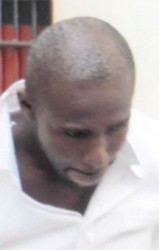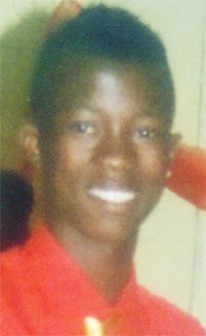Six witnesses, four police officers among them, testified yesterday when the trial of former police constable Terrence Wallace, who stands accused of the September 2012 murder of 17-year-old Shaquille Grant at Agricola, East Bank Demerara opened before Justice Navindra Singh.
In her opening address to the jury, Prosecutor Judith Gildharie-Mursalin said that in September 2012, Wallace, who was attached to the Tactical Services Unit (TSU), went with other TSU ranks to Caesar Street, Agricola.

The prosecutor said that according to civilian accounts, once there, Wallace ordered Grant and three young men who were with him at the time, to lie on the ground. She said that as they were complying with the instruction from Wallace, Romel Bollers, one of the persons in Grant’s company, was taking his cell phone from his pocket, when there was a bang which appeared to be a gunshot.
The prosecutor said Bollers was shot to the head, while Grant was heard saying, “officer, officer, I get shoot.” She said that what appeared to be other gunshots, rang out and following the shooting, Bollers was injured and Grant “was dead.”
The court heard from Gildharie-Mursalin that according to the police’s version, Bollers was attempting to run away from them, and at the same time, had discharged a round at them from a weapon which he had. “The officers claimed that the action by Bollers was the catalyst for their shooting,” said Gildharie-Mursalin, who is appearing for the state in association with attorney Narissa Leander.
The court was told by the prosecutor that on the day in question, Wallace and two other ranks were detailed to perform motorcycle patrol duties in Georgetown.
She said that Lance Corporal Warren Blue and special constable Jamal Lewis who were also charged with Grant’s murder, were designated to perform vehicular patrol duties in the Kitty area with three other ranks. She said Blue was the officer in charge of that patrol.

State counsel revealed that the officers were all issued with guns and ammunition; Wallace had been issued with a 9mm Glock pistol and 17 live rounds of matching ammunition.
She said that at about 10 am on the day in question, Grant was sitting in the garage area of a yard at Lot 110 Caesar Street together with Bollers, Troy Greenidge and Jamal Henry called ‘Tuna’.
The court heard that one Travis David, Wallace’s cousin, who was one of the residents of the house at that location enquired from the young men what they were doing there to which they responded that they were “just liming.”
The prosecutor said that after David spoke with the young men, he called Wallace, to whom he give certain information about the young men.
Acting on his cousin’s telephone call, Gildharie-Mursalin said, Wallace, without permission from his superiors, mobilized a number of ranks and went to Caesar Street where the shooting took place.
Following the shooting, both Bollers and Grant were taken to the Georgetown Public Hospital where Grant was pronounced dead, while Bollers received medical attention.
State counsel told the court that Lewis and Blue were never arrested, noting that the latter was subsequently shot and killed during a botched robbery on the East Coast Demerara. Warrants had been issued for their arrest.
Firing orders
Testifying yesterday, Police Corporal Eon Isaacs who is stationed at the TSU and was attached to the patrol section in 2012, with responsibility for dispatching ranks in various areas of patrol, recalled briefing ranks, including the accused, on the morning of September 11, 2012 and giving the usual firing orders.
He said that firing orders entailed the circumstances under which the use of the gun should be resorted to, highlighting that this could be when a police officer is under attack and has to prevent serious injury to his person or when someone is seen committing a felony and fails to desist after being warned. He said too that there were certain instances when an arrest is being made and also when such orders are given by a superior in rank. Isaacs said firing orders are given so that ranks can “use their judgement in the use of the firearm.”
He said that after the briefing, the ranks were then issued with firearms and ammunition.
Responding to questions from state counsel, the witness said that a police officer is not supposed to leave his designated area of patrol. And if such a need arises, this must be communicated to the superior on the patrol and the Brickdam Police Station must also be informed of such a development.
However, he emphasized, “They are not supposed to leave that area without permission.”
Asked under cross-examination by defence attorney Sonia Parag, whether an officer has to wait for orders from a superior where there is imminent danger, Isaacs said no. When further questioned, he answered in the affirmative when asked if was lawful for an officer to resort to the use of the gun in such a scenario.
Police Sergeant Bowman, also stationed at the TSU, recalled that his duties in 2012 entailed the issuing of firearms and ammunition to ranks proceeding on patrol and collecting same afterwards.
He said that on September 11, he issued Wallace with a 9mm Glock pistol and 17 live matching rounds. Asked by the prosecutor if he had collected the firearm and ammunition from Wallace, Bowman answered in the negative, explaining that he was not on duty at the time the items were returned.
Corporal Donald Harry, who is also stationed at the TSU, recalled being on duty when Wallace’s weapon was returned. He said the ammunition came back one short; only 16 live rounds were returned. He was attached to the arms room of the TSU in 2012 with responsibility for issuing and receiving firearms and ammunition.
Superintendent of Police Hugh Jessemy testified to visiting the scene after receiving information about a fatal shooting. He said that on his arrival, he saw a number of policemen and three males lying face-down in a passageway.
He said immediately instructed that the three men be escorted to the Ruimveldt Police Station for questioning.
Jessemy said later that day, he visited the GPH, where he was shown the body of a person whose name he later learnt was Shaquille Grant. He said he observed a circular wound on the right forehead, another in the vicinity of the left side of his chest along with what appeared to be lacerations on the inner left thigh.
Grant resided at Lot 72 ‘BB’ Eccles, East Bank Demerara.
Grant’s grandparents also testified. They recalled identifying their grandson’s body to Pathologist D. Nehaul Singh, who performed a post-mortem examination before the body was handed over to the family for burial.
Grant’s mother was among those seated in the public gallery, listening intently as each witness testified.
The state is expected to call 21 witnesses.





